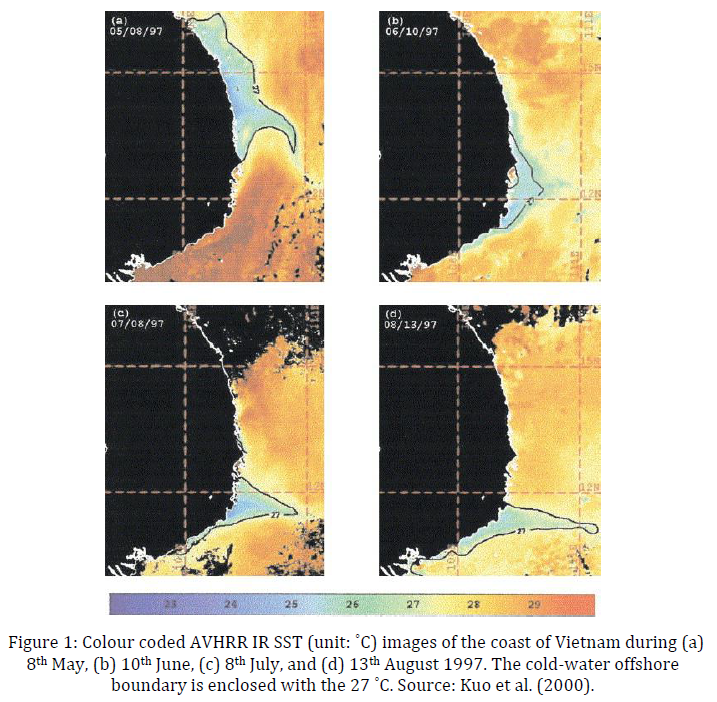Upwelling Along the Coast of Vietnam
The upwelling region along the coast of Vietnam is demonstrated by a low sea surface temperature (SST) that is 1 ˚C cooler than the long-term average (Levitus, 1984). In boreal summer, the north-south orientation of the coast of Vietnam and the southwesterly monsoon winds parallel to the coast is an important driving factor for the coastal upwelling along the coast of Vietnam (Chu et al., 1998; Huang et al., 1994; Pohlmann, 1987; Shaw and Chao, 1994; Wyrtki, 1961) either by means of offshore Ekman transport due to the prevailing alongshore winds (Dippner et al., 2007; Wang et al., 2013) or by Ekman pumping due to wind stress curl (Wang et al., 2013; Xie et al., 2003). The upwelling starts in May in the western part of Vietnam and moves southward in June, reaching its peak intensity in August before disappearing in October (Kuo et al., 2000). The key feature of this upwelling area is the development of cold band water along the coast of Vietnam initially, and it migrates southward and gradually spread eastward, becoming a cold filament near 12 ˚N latitude (Figure 1) sandwiched between a cyclonic eddy in the central coast of Vietnam and an anticyclonic eddy in the southwestern part of the south China Sea (SCS) (Gan and Qu, 2008; Kuo et al., 2004; Zu et al., 2020). Remote sensing and modelling studies have shown that the upwelling region along the coast of Vietnam is the most productive area in the SCS, with high surface chlorophyll concentrations of close to 2 mg m-3 and close to 80 mmol C m-2 d-1 of modelled primary productivity (Liu et al., 2002; Tang et al., 2004a, 2004b). Previous studies have shown that the upwelling along the coast of Vietnam exhibited interannual variability that is closely linked to ENSO (Dippner et al., 2007; Kuo et al., 2004; Xie et al., 2003). The upwelling along the coast of Vietnam was enhanced during the El Niño year owning to the strengthening of the southwest monsoon wind (Kuo et al., 2004). A contradict situation occurred during the summer following El Niño where the upwelling along the coast of Vietnam was weakened owning to the weakening of the southwest monsoon wind (Dippner et al., 2007; Kuo et al., 2004; Xie et al., 2003), resulting in a sharp decline in chlorophyll-a concentration and primary productivity (Bombar et al., 2010; Zhao and Tang, 2007).

References
Bombar, D., Dippner, J.W., Doan, H.N., Ngoc, L.N., Liskow, I., Loick-Wilde, N., Voss, M., 2010. Sources of new nitrogen in the Vietnamese upwelling region of the South China Sea. J. Geophys. Res. 115. https://doi.org/10.1029/2008JC005154
Chu, P.C., Fan, C., Lozano, C.J., Kerling, J.L., 1998. An airborne expendable bathythermograph survey of the South China Sea, May 1995. J. Geophys. Res. 103, 21637–21652. https://doi.org/10.1029/98JC02096
Dippner, J.W., Nguyen, K.V., Hein, H., Ohde, T., Loick, N., 2007. Monsoon-induced upwelling off the Vietnamese coast. Ocean Dyn. 57, 46–62. https://doi.org/10.1007/s10236-006-0091-0
Gan, J., Qu, T., 2008. Coastal jet separation and associated flow variability in the southwest South China Sea. Deep Sea Res. Part I Oceanogr. Res. Pap. 55, 1–19. https://doi.org/10.1016/j.dsr.2007.09.008
Huang, Q.Z., Wang, W.Z., Li, Y.S., Li, C.W., 1994. Current characteristics of the South China Sea, in: Zhou, D., Liang, Y.B., Tseng, C.K. (Eds.), Oceanology of China Seas. Springer, Dordrecht, pp. 39–47.
Kuo, N.-J., Zheng, Q., Ho, C.-R., 2004. Response of Vietnam coastal upwelling to the 1997–1998 ENSO event observed by multisensor data. Remote Sens. Environ. 89, 106–115. https://doi.org/10.1016/j.rse.2003.10.009
Kuo, N.-J., Zheng, Q., Ho, C.-R., 2000. Satellite observation of upwelling along the western coast of the South China Sea. Remote Sens. Environ. 74, 463–470. https://doi.org/10.1016/S0034-4257(00)00138-3
Levitus, S., 1984. Annual cycle of temperature and heat storage in the world ocean. J. Phys. Oceanogr. 14, 727–746. https://doi.org/10.1175/1520-0485(1984)014<0727:ACOTAH>2.0.CO;2
Liu, K.-K., Chao, S.-Y., Shaw, P.-T., Gong, G.-C., Chen, C.-C., Tang, T.Y., 2002. Monsoon-forced chlorophyll distribution and primary production in the South China Sea: Observations and a numerical study. Deep Sea Res. Part I Oceanogr. Res. Pap. 49, 1387–1412. https://doi.org/10.1016/S0967-0637(02)00035-3
Pohlmann, T., 1987. A three-dimensional circulation model of the South China Sea, in: Nihoul, J.J., Jamart, B.M. (Eds.), Three-Dimensional Model of Marine and Estuarine Dynamics. Elsevier, New York, pp. 245–268.
Shaw, P.-T., Chao, S.-Y., 1994. Surface circulation in the South China Sea. Deep Sea Res. Part I Oceanogr. Res. Pap. 41, 1663–1683. https://doi.org/10.1016/0967-0637(94)90067-1
Tang, D.L., Kawamura, H., Doan-Nhu, H., Takahashi, W., 2004a. Remote sensing oceanography of a harmful algal bloom off the coast of southeastern Vietnam. J. Geophys. Res. Ocean. 109. https://doi.org/10.1029/2003JC002045
Tang, D.L., Kawamura, H., Van Dien, T., Lee, M.A., 2004b. Offshore phytoplankton biomass increase and its oceanographic causes in the South China Sea. Mar. Ecol. Prog. Ser. 268, 31–41. https://doi.org/10.3354/meps268031
Wang, D., Wang, H., Li, M., Liu, G., Wu, X., 2013. Role of Ekman transport versus Ekman pumping in driving summer upwelling in the South China Sea. J. Ocean Univ. China 12, 355–365. https://doi.org/10.1007/s11802-013-1904-7
Wyrtki, K., 1961. Physical oceanography of the Southeast Asian waters, in: NAGA Report. University of California, La Jolla, p. 195.
Xie, S.-P., Xie, Q., Wang, D., Liu, W.T., 2003. Summer upwelling in the South China Sea and its role in regional climate variations. J. Geophys. Res. 108. https://doi.org/10.1029/2003JC001867
Zhao, H., Tang, D.L., 2007. Effect of 1998 El Niño on the distribution of phytoplankton in the South China Sea. J. Geophys. Res. 112. https://doi.org/10.1029/2006JC003536
Zu, T., Wang, D., Wang, Q., Li, M., Wei, J., Geng, B., He, Y., Chen, J., 2020. A revisit of the interannual variation of the South China Sea upper layer circulation in summer: correlation between the eastward jet and northward branch. Clim. Dyn. 54, 457–471. https://doi.org/10.1007/s00382-019-05007-5
